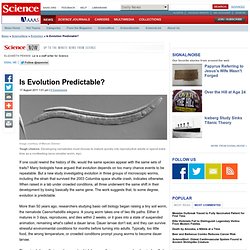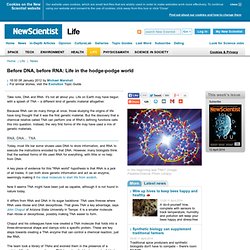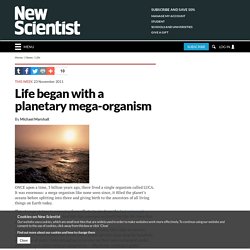

Dev. Dev. Evolution: This View of Life Magazine. The False Allure Of Group Selection. I am often asked whether I agree with the new group selectionists, and the questioners are always surprised when I say I do not.

After all, group selection sounds like a reasonable extension of evolutionary theory and a plausible explanation of the social nature of humans. Also, the group selectionists tend to declare victory, and write as if their theory has already superseded a narrow, reductionist dogma that selection acts only at the level of genes. In this essay, I'll explain why I think that this reasonableness is an illusion. The more carefully you think about group selection, the less sense it makes, and the more poorly it fits the facts of human psychology and history. Why does this matter? The first big problem with group selection is that the term itself sows so much confusion. Evolutionary theory can make street life better - life - 29 August 2011. Read full article Continue reading page |1|2 Can we use evolutionary biology to improve people's lives?

A FEW years ago, it struck me that Darwin's theory of evolution could be used to make our lives better in a practical sense. As someone who has spent a lifetime studying evolution, this was a road to Damascus moment. Reborn, I left my ivory tower to see if I could make a difference in my own city of Binghamton, New York, and worldwide through the creation of the Evolution Institute, the world's first evolutionary think tank.
Is Evolution Predictable? If one could rewind the history of life, would the same species appear with the same sets of traits?

Many biologists have argued that evolution depends on too many chance events to be repeatable. But a new study investigating evolution in three groups of microscopic worms, including the strain that survived the 2003 Columbia space shuttle crash, indicates otherwise. When raised in a lab under crowded conditions, all three underwent the same shift in their development by losing basically the same gene.
The work suggests that, to some degree, evolution is predictable. More than 50 years ago, researchers studying basic cell biology began raising a tiny soil worm, the nematode Caenorhabditis elegans.
How Life Arose on Earth, and How a Singularity Might Bring It Down. It didn’t take long for the recent Foundational Questions Institute conference on the nature of time to delve into the purpose of life.

“The purpose of life,” meeting co-organizer and Caltech cosmologist Sean Carroll said in his opening remarks, “is to hydrogenate carbon dioxide.” Well, there you have it. Carroll is one of the most reflective scientists I know and would never claim to reduce all of human existence to molecular disequilibrium. Still, it’s nice to know your place in the grand scheme of things. The FQXi meeting had much to say about where we came from—and where we’re headed.
Before DNA, before RNA: Life in the hodge-podge world - life - 08 January 2012. Take note, DNA and RNA: it's not all about you.

Fossil DNA has clues to surviving rapid climate change - life - 31 January 2012. Read full article Continue reading page |1|2 Surviving the last ice age was more than just a matter of growing a woolly coat.

Rapid global temperature swings had to be matched by equally rapid adaptation. Prions point to a new style of evolution - life - 15 February 2012. By Andy Coghlan THE rogue proteins behind variant CJD, the human form of mad cow disease, have revealed their benign side.

Prions, it seems, lie at the heart of a newly discovered form of near-instant evolution that provides life with a third way to adapt to potentially lethal environments. Crucially, it involves neither genetic nor epigenetic changes to DNA. The conventional view is that new traits can only evolve if DNA itself changes in some way. The classic way to do this is by mutating the genetic code itself. Yeast breaks the mould. Russian hot springs point to rocky origins for life - life - 13 February 2012.
Read full article Continue reading page |1|2 New findings challenge the widespread view that it all kicked off in the oceans.

Life may have begun on land instead – just as Darwin thought. Life began with a planetary mega-organism - life - 25 November 2011. By Michael Marshall ONCE upon a time, 3 billion years ago, there lived a single organism called LUCA.

It was enormous: a mega-organism like none seen since, it filled the planet’s oceans before splitting into three and giving birth to the ancestors of all living things on Earth today. This strange picture is emerging from efforts to pin down the last universal common ancestor – not the first life that emerged on Earth but the life form that gave rise to all others. Avalanche of Reactions at the Origin of Life. Mechanism of evolution of the primordial metabolism discovered Volcanic-hydrothermal flow channels offer a chemically unique environment, which at first glance appears hostile to life.

This environment is defined by cracks in the crust of the earth through which water flows. First top predator was giant shrimp with amazing eyes - life - 07 December 2011. Half a billion years ago, sea creatures fled from a terrifying new creature: a gigantic primordial shrimp with pin-sharp vision. It is one of the oldest known animals with compound eyes, the hallmark of modern insects and crustaceans. Anomalocaris – the name means "strange shrimp" – is the . At 90 to 200 centimetres long, it was the largest animal in the Cambrian seas. It had formidable grasping claws, which allowed it to grab its prey and pull it into its mouth. Lacking legs, it must have swum in open water. ‘Rigid Swimmer’ and the Cretaceous Ichthyosaur Revolution (part I) You’re reading a blog. This almost guarantees the fact that you’re a staunch supporter, and fan, of open-access publishing.
Many of us who publish technical research really do try to publish in open-access venues as often as possible. Doing so is generally good for citation indices and all that, but it’s especially important if you care about outreach and about the public availability of your research. I’ve published in open-access journals before (Witton & Naish 2008, Taylor et al. 2009), and I’m very happy to say that my very newest paper – it’s out today – is published in the open-access, 100% available-to-all journal PLoS ONE. The new Hauterivian ophthalmosaurine ichthyosaur Acamptonectes densus Fischer et al., 2012, as reconstructed by C. The article concerned is co-authored with Valentin Fischer, Michael Maisch and others and is predominantly based around the naming of a very interesting new Cretaceous ichthyosaur (Fischer et al. 2012).
Biology’s Big Bang Had A Long Fuse. Meet plants' and algae's common ancestor: Primitive organisms not always so simple, researcher says. A University of Arkansas biologist has created a sketch of what the first common ancestor of plants and algae may have looked like. He explains that primitive organisms are not always simple. The image appears as part of a "Perspective" article in the Feb. 17 issue of Science.
Fred Spiegel, professor of biological sciences in the J. William Fulbright College of Arts and Sciences, suggests what microscopic parts would have been present in this common ancestor based on findings by Dana Price of Rutgers University and his colleagues, who examined the genome of a freshwater microscopic algae and determined that it showed that algae and plants are derived from one common ancestor. Twist in the tail of eukaryotic origins - life - 19 December 2011. Complex life may have had parasitic origins. New evidence suggests that the relatives of the mitochondria within our cells once had a tail, like many parasitic bacteria. Life on Earth is packaged into three domains: the simple bacteria, the archaea, and the complex eukaryotes that make up most of the life we see with the naked eye.
The first eukaryotes appeared around 2 billion years ago. What facts support evolution. Oldest reliable fossils show early life was a beach - life - 21 August 2011. The oldest compelling fossil evidence for cellular life has been discovered on a 3.43-billion-year-old beach in western Australia. Grains of sand there provided a home for cells that dined on sulphur in a largely oxygen-free world. The rounded, elongated and hollow tubular cells – probably bacteria – were found to have clumped together, formed chains and coated sand grains. Similar sulphur-processing bacteria are alive today, forming stagnant black layers beneath the surface of sandy beaches. The remarkably well-preserved three-dimensional microbes will help resolve a fierce and long-running debate about what is the oldest known fossil – or at least add to it.
In 1993, William Schopf of the University of California, Los Angeles, claimed he had discovered fossils that are 35 million years older than the present find in nearby deposits known as the Apex chert. Reasons to believe Real old The team's findings have been well received so far. Traces Of Inaugural Life. Fossils Show Signs Of Earliest Burrowing. Biological clock began ticking 2.5 billion years ago - life - 16 May 2012.
OUR core physiology relies on subtle organic timers: disrupt them, and effects range from jet lag to schizophrenia. Exactly how and when life began keeping time is unclear, but a candidate for the original biological clock may solve the mystery. In The Beginning Was the Mudskipper? In 1893, the Norwegian zoologist Fridtjof Nansen set off to find the North Pole. He would not use pack dogs to cross the Arctic Ice. Instead, he locked his fate into the ice itself. Permian Extinction Article, Mass Extinction Information, Park Tourism Facts. Written by Hillel J. Acid Oceans Helped Fuel Mass Extinction. Calcium Offers Clues In Mass Extinction. Earth's time bombs may have killed the dinosaurs - environment - 27 July 2011.
Old-fashioned Fish Regrow Fins. Amber reveals earliest example of pollinating insects. Caroline Morley, online picture researcher (Image: Enrique Peñalver, IGME) Insects and plants have a long, entwined history through pollination. Plants attract insects through their flowers' colour and scent, often providing their visitors with food. For their part, the insects unwittingly carry the pollen from one plant to another thus playing a key role in the plant's sexual reproduction. Worm Discovery Illuminates How Our Brains Might Have Evolved. Our earliest invertebrate ancestors did not have brains. Yet, over hundreds of millions of years, we and other vertebrates have developed amazingly complicated mental machinery. "It must have evolutionary roots somewhere, but where? " wrote Henry Gee, an editor at Nature, in an essay published in the journal's March 15 issue. Giant Flea-Like Pest Put the Bite on Dinosaurs.
Paleo-pests about 10 times bigger than today's fleas may have sneaked up on a huge dinosaur, crawled onto its soft underbelly and taken a bite, likely a painful one, say researchers who have discovered fossils of the flealike organisms. "It would have felt about like a hypodermic needle going in, a flea shot, if not a flu shot," George Poinar Jr., a professor emeritus of zoology at Oregon State University, said in a statement. "We can be thankful our modern fleas are not nearly this big," said Poinar, who wrote a commentary alongside the research article published online April 24 in the journal Current Biology.
One possible lifesaver for dinosaurs: These bloodsuckers couldn't jump like today's pesky fleas. Ancient Birds Wiped Out Huge Insects. "Alternative Evolution" of Dinosaurs Foresaw Contemporary Paleo Finds. In a geologic instant, the K-T extinction event about 65 million years ago left Earth's skies empty of pterosaurs, extirpated the mosasaurs and their ammonite prey from the seas, and, of course, denuded the land of non-avian dinosaurs. Dinosaurs Grew to Outpace Their Young. National Geographic Society/Corbis. Microraptor's glossy black feather coat reconstructed - life - 08 March 2012. Birds got smart by becoming big babes - life - 28 May 2012. Triumph of the Titans: How Sauropods Flourished. Oldest Animals Ever Discovered. Oldest chordate spawned everything with backbones. Fossil Pushes Back Land-animal Debut. Ancient Sea Jelly Shakes Evolutionary Tree of Animals. Evolution Shrinks Mammals Quickly, But They're Slow to Grow.
Mini-mammoths lived on Crete. Oceans Set Stage For Human Evolution. Meet Your Newest Ancestor. Tibet Was Cradle of Evolution for Pre-Ice Age Mammals. First Horses Shrunk by Hot Weather. Missing link found? Scientists unveil fossil of 47 million-year-old primate, Darwinius masillae. Geneticists Go Ape For Better Primate Family Tree. Out of Asia: How Monkey and Ape Ancestors Colonized Africa.